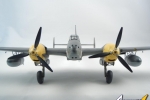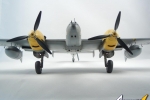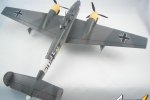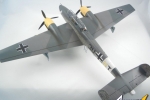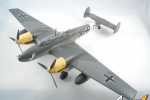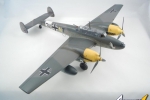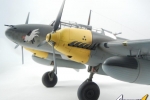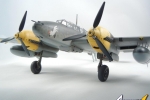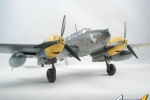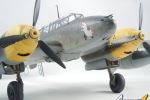1⁄32Dragon's Destroyer: 1/32 Bf-110D-3
1
Comment
history
The Messerschmitt Bf 110, often erroneously called Me 110, was a twin-engine heavy fighter (Zerstörer; German for "Destroyer") in the service of the Luftwaffe during World War II. Hermann Göring was a proponent of the Bf 110, and nicknamed it his Eisenseiten ("Ironsides"). Development work on an improved type to replace the Bf 110, the Messerschmitt Me 210 began before the war started, but its teething troubles resulted in the Bf 110 soldiering on until the end of the war in various roles, alongside its replacements, the Me 210 and the Me 410.The Bf 110 served with success in the early campaigns, the Polish, Norwegian and Battle of France. The Bf 110's lack of agility in the air was its primary weakness. This flaw was exposed during the Battle of Britain, when some Bf 110-equipped units were withdrawn from the battle after very heavy losses and redeployed as night fighters, a role to which the aircraft was well suited. The Bf 110 enjoyed a successful period following the Battle of Britain as an air superiority fighter and strike aircraft in other theatres. During the Balkans Campaign, North African Campaign and on the Eastern Front, it rendered valuable ground support to the German Army as a potent fighter-bomber (Jagdbomber or Jabo). Later in the war, it was developed into a formidable night fighter, becoming the major night-fighting aircraft of the Luftwaffe. Most of the German night fighter aces flew the Bf 110 at some point during their combat careers, and the top night fighter ace of all time, Major Heinz-Wolfgang Schnaufer, flew it exclusively and claimed 121 victories in 164 combat missions.
This brief history was adapted from Wikipedia.
the model
I did an in-box review of this kit earlier this year, and wanted to build the kit to see if it was as good as it looked in the box.Overall, I was pleased with this kit, and will certainly build another one. The only issues I came across with this kit were:
- 1. some missing information in the instructions (mostly dealing with the placing of cockpit details)
- 2. a couple minor fit issues (likely self-inflicted) around the rear fuselage insert and nose underside.
- 3. the kit-provided wire dingy release cable (unique to the D series) is incorrectly shaped
- 4. the kit is missing the exhaust deflector on the inboard starboard engine cowl that was added to D/E series aircraft
For full details of the build, I invite you to review the build log. For those who want to improve the look of their kit, I would recommend the following additional modifications:
- 1. I would replace the two antennae under the fuselage with some fine wire, as the kit provided part has somewhat thick plastic antennae.
- 2. I would replace the kit MG barrels with brass barrels from Master Model (or equivalent)
- 3. Add the missing exhaust deflector for D/E series models
- 4. Some of the Eduard PE parts for the cockpit do look better than the kit parts, and since the model does have a large glass canopy, these parts may be visible after the build is completed.
I used Mr. Color paints, Eduard canopy masks and the kit decals for this build.
Comments
Nice one Doug!
That really does look superb! The extra details you outlined in your Blog are an inspiration.
All the best
Rowan
MAR 23, 2013 - 09:01 PM
Copyright ©2021 by Doug Nelson. Images also by copyright holder unless otherwise noted. The views and opinions expressed herein are solely the views and opinions of the authors and/or contributors to this Web site and do not necessarily represent the views and/or opinions of AeroScale, KitMaker Network, or Silver Star Enterrpises. Images also by copyright holder unless otherwise noted. Opinions expressed are those of the author(s) and not necessarily those of AeroScale. All rights reserved. Originally published on: 2013-03-22 23:47:50. Unique Reads: 13657





